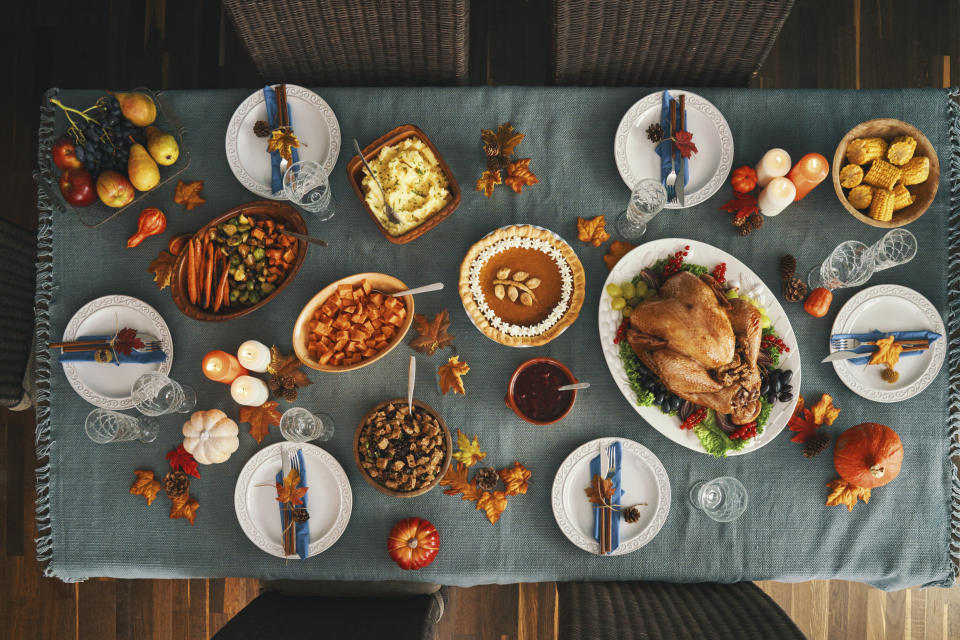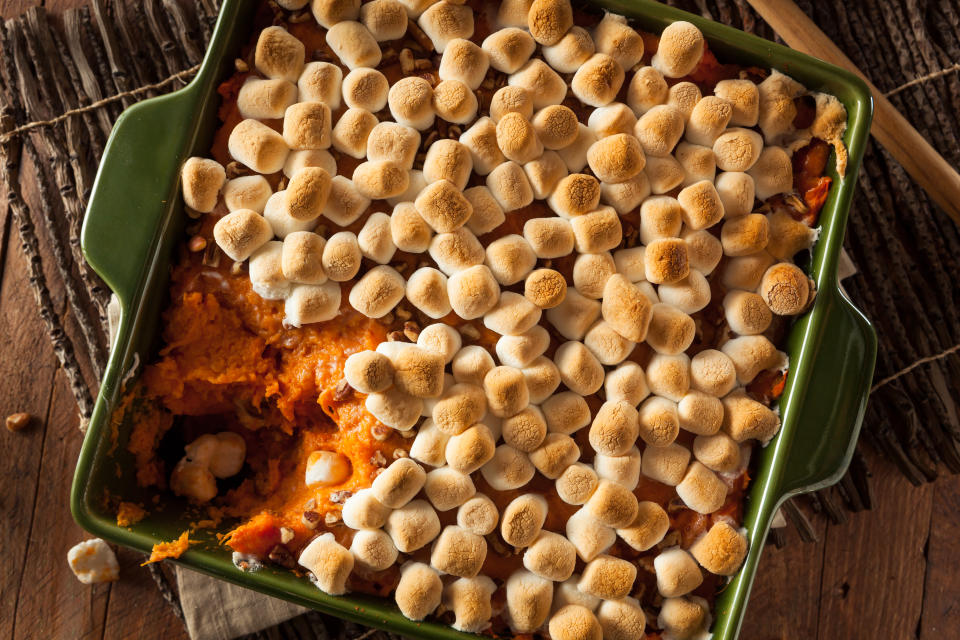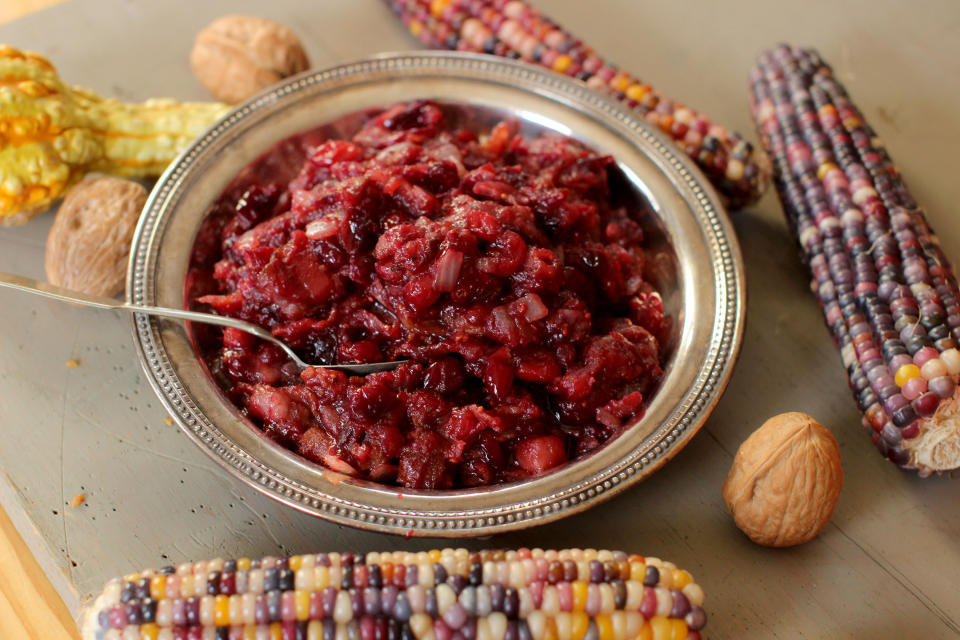Thanksgiving's most popular side was a 'surprise hit' — and people either love it or hate it

No Thanksgiving meal would be complete with a plethora of sweet and savory side dishes — from stuffing and sweet potatoes to cranberry sauce and green bean casserole — to round out the meal.
But do you know why these specific side dishes make an appearance at nearly every Thanksgiving table? Yahoo Life reached out to culinary expert and author of Thanksgiving 101 Rick Rodgers, food historian Sarah Wassberg Johnson, and Tonya Hopkins, food historian and co-founder of the James Hemings Society, to shed some light on the history of some of the most common side dishes served on Thanksgiving — and how they became so popular.
To enhance the experience of learning about the history of Thanksgiving sides, we've created a 3D experience. Launch the experience below (best viewed on mobile) to learn more.
Green bean casserole

Green bean casseroles are a sentimental favorite for some on Thanksgiving. In fact, according to Google’s The Keyword, it’s the most popular side dish in 26 states.
The affordable, fool-proof vegetable dish was the “brainchild” of Dorcas Reilly, a home economist who developed the recipe in 1955 specifically to promote cream of mushroom soup. It ended up being a “surprise hit,” says Johnson, and quickly became a holiday staple. (Reilly donated her original recipe card for “Green Bean Bake” to the National Inventors Hall of Fame archives in 2002.)
According to Smithsonian magazine: “It was the perfect recipe for post-War America, when cheap, fuss-free cooking was all the rage.”
Adds Rodgers: “This may be the ultimate Thanksgiving dish with a direct connection to the power of advertising.”
Stuffing

It’s hard to imagine Thanksgiving turkey without its favorite sidekick, stuffing. Rodgers tells Yahoo Life that stuffing was originally used as a way of stretching the meal for large groups. He says: “When Thanksgiving came to be in the 1860s” — President Abraham Lincoln declared Thanksgiving a national holiday in 1863 — “the combination of bread crumbs or cubes, celery, onion, and sage with other herbs was a known accompaniment for chicken or goose, and easy to translate to turkey.”
But stuffing goes back even further than the Thanksgiving holiday. “When roasting meats, stuffing the abdominal cavity with other foods is, indeed, very ancient, [and was] in use in ancient Roman and Arab countries,” says Johnson.
Stuffing is known by different names throughout the U.S. According to History.com: “Northerners call it ‘stuffing,’ Southerners eat ‘dressing’ [usually made alongside, rather than in, the turkey] and a few Pennsylvanians enjoy ‘filling’ on their Turkey Day tables.”
Also, different types of stuffing have fallen in and out of favor over the years. “The least-often used stuffing today is oysters, which were once a popular and inexpensive food,” says Johnson, “and often paired with other meats, including game meats.”
Many cooks make their own homemade stuffing for Thanksgiving. But the side dish became even easier to whip up when fool-proof Stove Top stuffing, which was invented by home economist Ruth Siems for General Foods, hit grocery stores in 1972, according to Allrecipes.com. Siems’ secret for success was her “patent for precise bread crumb dimensions,” according to Purdue University. “The processing technique allowed for quick re-hydration — essential for thorough stove-top preparation.”
Sweet potatoes

This is one of the most popular side dishes on Thanksgiving. In fact, according to the National Grocers Association, Americans buy 50 pounds of sweet potatoes the week before and the week of Thanksgiving.
Sweet potatoes are an “ancient food indigenous to Peru, and were popularized in Britain as well as in West Africa,” says Johnson. “The West African influence likely helped popularize sweet potatoes on Southern tables.” (Though in West Africa, it would have been a yam, which is a different vegetable.)
Sweet potato recipes in the U.S. date as far back as 1796, according to the Smithsonian magazine, “when Amelia Simmons published [the cookbook] American Cookery.” This was followed by recipes for candied sweet potatoes appearing in the late 1800s and early 1900s, according to the publication.
“By the latter half of the 19th century and [with] the widespread availability of cheap sugar, candied sweet potatoes were another popular recipe throughout the nation,” says Johnson. “The introduction of canned sweet potatoes only made the process easier.”
So where do the marshmallows come in? Pairing sweet potatoes with marshmallows appears to be “the result of a request by a marshmallow manufacturer for recipes” in the early 1900s, according to Johnson. “In general, marshmallows were very popular during the early 20th century when they began being mass-manufactured,” says Rodgers. “They showed up in everything, including many salads, like ambrosia and gelatin salads.”
Cranberry sauce

Cranberries are an indigenous fruit in North America. Wild cranberries were used by the Narragansett tribe in cooking, including in making pemmican, which is dried jerky with berries. “A kind of early energy bar,” says Rodgers.
Adds Johnson, “This was an important traveling food as the fat [from the meat] and acidity of the cranberries helps it resist spoiling.”
Native Americans also made the first cranberry sauce, according to the Smithsonian, with a chronicler observing “natives eating cranberry sauce with meats in the early 17th century.”
But as anyone who has ever used cranberries for baking — including sauces — knows, the fruit itself is very tart and requires a lot of sugar. British colonists only gained access to “plentiful sugar supplies... thanks to Caribbean slavery,” notes Johnson. It wasn’t unusual for the colonists’ to pair cranberries with meat since they had “their own culinary traditions of serving cooked sour fruits with game meats, like turkey,” says Johnson.
Cranberry sauce became more convenient and widespread thanks to Marcus L. Urann, a lawyer who bought a cranberry bog and started canning cranberries in 1912 to preserve their shelf life. The product became available nationwide in 1941, and was quickly adopted as a “Thanksgiving staple,” according to the Farmer’s Almanac. It reportedly takes 200 cranberries to make a single can of cranberry sauce.
Macaroni and cheese

While there’s some debate about who introduced macaroni and cheese to America, some food historians attribute it to Thomas Jefferson, a “famous foodie” who took his accomplished, enslaved chef James Hemings to France in 1784 “for the sole purpose of learning the French culinary arts” for five years, Hopkins tells Yahoo life.
Hemings “knocked it out of the park,” says Hopkins, learning and perfecting a variety of dishes, including macaroni and cheese. (In fact, Jefferson even got a machine to make handmade macaroni when he was back home at Monticello.)
Even if Jefferson didn’t introduce macaroni and cheese to North America, he certainly popularized it by serving the dish — considered part of “fine dining” — to his dinner guests. “This iconic foodie president whose table is more influential than any other and this trained chef and [you have this] ripple of fine dining rolling out in America,” says Hopkins.
However, the macaroni and cheese that Americans eat today is not like “any of the versions that James [Hemings] learned in France,” says Hopkins. “It’s one of those dishes that we turned into a uniquely American thing.”
It’s no surprise that the pasta dish eventually emerged as a classic comfort food — only to become even more popular (and affordable) after Kraft Foods launched boxed macaroni and cheese in 1937. “Americans love cheese,” Hopkins says. “It’s the perfect recipe for an American iconic dish. It’s comfort food. It’s fat and carbs together.”
Even though few realize macaroni and cheese’s role in fine dining, it helps explain how the pasta dish earned a special place on some Thanksgiving tables. “The dish becomes very precious,” says Hopkins, “and Thanksgiving is the biggest special occasion meal.”
In fact, according to Zippia.com, which looked at Google Trends data from November 2019, macaroni and cheese is the most popular side dish from Georgia all the way up the coast to Delaware.
Jell-O salads

While it’s not clear when exactly it ended up on the Thanksgiving table, Jell-O itself “dates back to the 1890s,” says Johnson, “and it was considered an easy and inexpensive dessert.”
In the 1960s, Jell-O tried to expand its range by releasing “savory and vegetable flavors such as celery [and] Italian (vegetable and seasoned tomato),” according to WhatsCookingAmerica.net. “Popular Jell-O recipes of the day included ingredients like cabbage, celery, green peppers, and even cooked pasta. The savory flavors have since been discontinued.”
An old ad even encouraged people to dump their Thanksgiving leftovers — vegetables, meat and all — into Jell-O, saying: “Use up your leftovers in a Jell-O salad!”
“As for savory gelatines, that was to mimic aspic or savory salads,” says Johnson. “So while putting your leftovers in Jell-O seems weird to us now, it does have historical reference.”
However, ambrosia salad, which can be made into a mold using gelatin, is still popular. Google’s The Keyword says that the fruity dish is a “uniquely highly-searched” item for people living in Oregon and South Dakota.
AR experience produced by Kat Vasquez.





